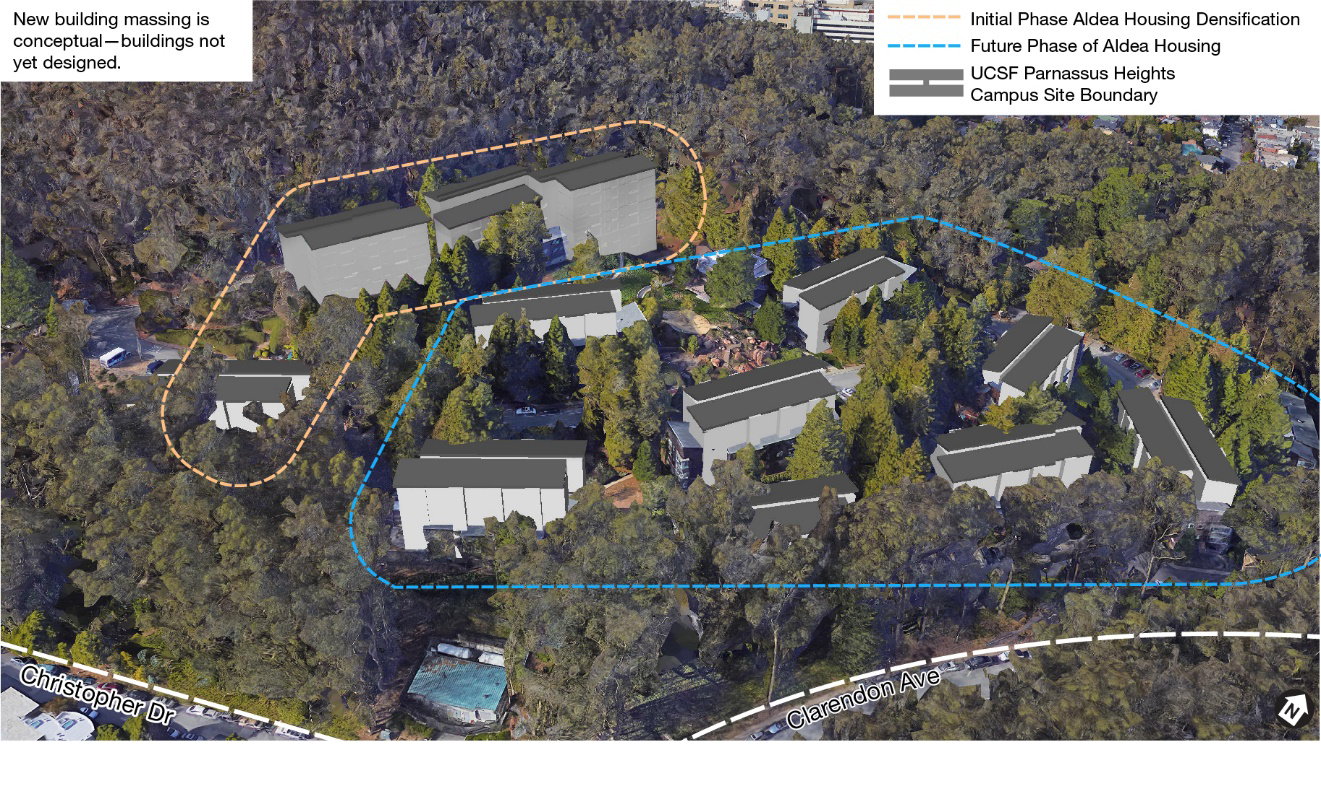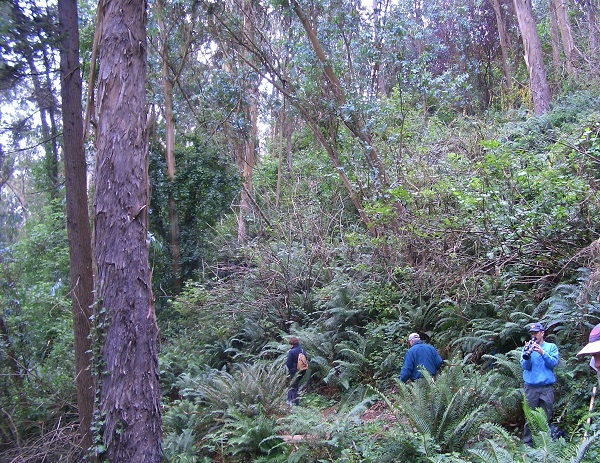From the time we established this website in 2009, we have battled a series of myths used to attack eucalyptus trees. One of the most pernicious is that the trees are short-lived, and so are dying of old age. We discovered that was not true, and dealt with it in our article, Eucalyptus Myths.
We are pleased to republish this very thorough article, which includes local examples of healthy eucalyptus trees over 150 years old. It is republished with permission and minor changes from Death of a Million Trees, a website that fights unnecessary tree killing in the San Francisco Bay Area.

PUTTING ANOTHER MYTH TO REST: LIFESPAN OF BLUE GUM EUCALYPTUS
When the native plant movement began in earnest, about 25 years ago, its proponents weren’t expecting blowback from those who value the existing landscape. As far as they were concerned, the trees had to be destroyed solely because they “don’t belong here.”
When they started destroying our predominantly non-native urban forest, they learned that it wasn’t going to be as easy as they thought. They began to defend their destructive projects with cover stories to convince the public who didn’t share their devotion to native plants that it is necessary to destroy non-native trees because they are a threat to public safety and to wildlife.
One by one, we have debunked the myths that were used to justify the destruction of our urban forest:

Great horned owl in eucalyptus. Courtesy urbanwildness.org
- About 20 years ago, one of the first myths was that eucalyptus trees kill birds. It is an absurd claim that is completely unsupported by reality. With a lot of careful research, we were eventually successful in convincing the public that birds are not harmed by eucalyptus. In fact, many bird species are dependent upon the trees for safe nesting and winter nectar. That myth is dead.
- The claim that eucalyptus and other non-native trees are more flammable than native trees was a powerful narrative that was more difficult to kill. As wildfires have increased in frequency and intensity in California, that claim is no longer credible because every wildfire occurs in native vegetation. Again, this myth was eventually disproved by reality.
- More recently, we have finally put to rest the claim that “nothing grows under eucalyptus.” This myth was based on a theory that eucalyptus emits allelopathic chemicals that prevent the growth of plants in the eucalyptus forest. Thanks to a recent, rigorous study done at Cal Poly, we know with confidence that the allelopathy story is another myth.
It was not surprising that the nativists, having run out of bogus justifications, created a new narrative. In parks that the East Bay Regional Parks District had been planning to thin, we began to see clear cuts. When we inquired about why it was necessary to destroy ALL of the trees, we were told they were hazardous. Then, in the minutes of a meeting of East Bay Regional Park District Park Advisory Committee , we saw the claim that eucalyptus lives only 50-60 years. Simultaneously, this claim was made in San Francisco by proponents of destroying all eucalyptus trees there.
We eventually tracked down the source of that lifespan estimate to a website called SelecTree, which originally said that the longevity of blue gums is only 50-150 years. We knew that isn’t an accurate estimate because of how long blue gums live in Australia and how long they have already lived in California. We provided that information to the authors of SelecTree and were able to get the estimate corrected to “greater than 150 years.” That’s not nearly long enough, but it is the longest lifespan estimate available on that website and it corresponds with many other trees, including native Coast Live Oak.
In the process of researching the lifespan of eucalyptus, we learned several interesting stories about blue gums that have lived in California for 150 years and are still going strong. We would like to share some of this information with our readers today.
BLUE GUM EUCALYPTUS IN AUSTRALIA LIVES 200-400 YEARS
Blue gum eucalyptus and all other species of eucalyptus are native to Australia. They were brought to California shortly after the Gold Rush of 1849. Since they haven’t been in California 200 years, we don’t know how long they will live here. But how long they live in Australia is obviously relevant to answer that question because longevity is specific to tree species. We can expect some variation by climate, but not much, and the climate of Australia is similar to the climate in California with wet, mild winters and hot, dry summers.
We know that blue gums live in Australia about 200-400 years because Australian scientists tell us that:
Growth Habits of the Eucalypts by M.R. Jacobs, (Institute of Foresters of Australia, 1955, 1986): “Blue Gum eucalyptus lives in Australia from 200-400 years, depending upon the climate.” In milder climates, such as San Francisco, the Blue Gum lives toward the longer end of this range.
That reference was corroborated by John Helms, Professor Emeritus of Forestry at UC Berkeley and an Australian who said in response to our question about blue gums in California, “Blue gums would commonly live for 200 – 400 years, although I presume that some might live longer.”
We also asked the Australian National Botanic Gardens. They said, “It’s possible that the average lifespan of a native species growing in the wild in Australia would differ to the average lifespan of the same species introduced in northern California, since introduced plants can often “escape” their natural predators when such introductions occur.”
In other words, since eucalyptus trees have more predators in Australia than they do in California, we should expect them to live longer here. This is called the “predator release” hypothesis. Ironically, that hypothesis is used by nativists to support their claim that eucalyptus is invasive in California. (California Invasive Plant Council rates the “invasiveness” of blue gum as “limited.) It’s only logical to apply that hypothesis to the question of how long blue gums will live in California.
MANY HEALTHY BLUE GUMS IN CALIFORNIA ARE 150 YEARS OLD
However, using actual experience in Australia to predict the future of blue gums in California requires some speculation. Therefore, we turned to the question of how long they have lived in California for guidance. We found several interesting local stories about blue gums that were planted in California 150 years ago and remain healthy and vigorous today.
There are many examples of blue gums being planted as street trees in California about 150 years ago. One of the most well-known examples is the city of Burlingame on the San Francisco peninsula. When the City was founded in the 1870s, John McLaren was hired to plant trees to provide a much needed windbreak because the City was nearly treeless, as was the entire San Francisco peninsula. McLaren planted over 500 eucalyptus (blue gum and manna) along the main highway through Burlingame, along with a row of English elms. John McLaren was subsequently hired by the city of San Francisco, where he planted many more eucalypts while serving as superintendent of the parks department for 53 years.
The eucalypts in Burlingame are still thriving, but the elms have been dead for about 60 years. SelecTree says the longevity of English elms is “greater than 150 years,” the longest category of longevity published by SelecTree and completely open-ended.

El Camino Real bordered by Eucalyptus trees. Burlingame, SF Bay area, California, USA
The people of Burlingame greatly value their eucalypts and designated them as “heritage trees” in 1975 under a local ordinance. That local legal status did not protect them from several attempts by Caltrans to destroy the trees. The people of Burlingame came to the defense of the trees and were eventually successful in getting permanent legal status to protect 2.2 miles of the trees. That section of El Camino Real in Burlingame lined with eucalyptus was listed on the National Register of Historic Places in 2012.
Caltrans is now working cooperatively with the people of Burlingame to address safety concerns while “also keeping an eye to the prized grove of eucalyptus trees along the street.” A task force was formed in 2018 to discuss these issues. The City of Burlingame remains committed to the preservation of these trees, which suggests that they have a future there. (1)
The life span of street trees is generally much shorter than trees planted as forests because they are subjected to more wind and polluted air of heavily traveled roads, such as El Camino Real. Although blue gums have passed the test of those challenging conditions with flying colors, they have not been planted as street trees for decades. Their out-sized scale makes them unsuitable for that purpose. If blue gums can survive as street trees on heavily traveled roads, they can surely survive longer in the protection of their neighbors in forests.
BLUE GUMS AT STANFORD UNIVERSITY
The blue gums on the campus of Stanford University are another example of 150 year-old blue gums that are very much alive. Although blue gums were included in the campus landscape design of Frederick Law Olmsted in the 1880s, many of the blue gums actually predate his design: “Several hundred mighty giants on the campus date back prior to 1870 when Leland Stanford acquired several farm properties, one of which already had avenues of gum trees. They are mostly Tasmanian blue gums and red gums with a sprinkling of manna trees.”

Eucalyptus on Stanford campus
That description of the old blue gums was written in 1971. The trees are still alive and well. I worked on the Stanford campus for 10 years and walked among those trees at every opportunity.
AN EVEN OLDER OLMSTED DESIGN IN OAKLAND
Mountain View Cemetery in Oakland, California was designed by Frederick Law Olmsted in the 1860s. Like most of the East Bay, the site was treeless. Olmsted’s design was an eclectic collection of mostly non-native trees, including blue gums. The cemetery is on steep, windward facing hills, where the windbreak provided by blue gums is particularly valued.

Eucalyptus in Mountain View Cemetery, planted on an unirrigated windward facing hill. 2017
Olmsted designed a straight avenue through the cemetery lined with magnolia trees. Many of the magnolia trees have died and those that remain are in poor condition. SelecTree claims that the life span of Southern magnolia is “greater than 150 years,” which is contradicted by our local experience.
The current owner of the cemetery destroyed many of the blue gums about 5 years ago, in the middle of the extreme drought. He replaced many of the blue gums with redwoods. The redwoods are irrigated and are still surviving. I did not object to the removal of the blue gums because they are on private property. I confine my advocacy to healthy trees on public land.
LONG LIVE THE BLUE GUMS!
SelecTree has revised its listing of blue gum longevity based on the information we provided. The myth that our blue gums are dying of old age will not die as easily. We will have to repeat this information many times and in many different venues, just as we did for every other myth. If and when that particular myth dies, we can be sure there will be another waiting in the wings. Ideologies stubbornly persist, despite contradictory evidence. And yet, we just as stubbornly persist in defense of our urban forest.
(1) Here is the public record, on which my report about the trees in Burlingame is based:
https://burlingameproperties.com/articles/1607-burlingame-s-heritage-trees
https://www.smdailyjournal.com/news/local/future-plotted-for-burlingame-s-el-camino-real/article_a27c43c4-1dd1-11e8-8a5d-b31dfaa94144.html
http://www.burlingamevoice.com/2012/03/nationally-historic-100-years-of-protection-rewarded.html
https://tclf.org/landscapes/howard-ralston-eucalyptus-rows
http://articles.latimes.com/2003/aug/10/local/me-sbriefs10.1

THE END




























































































































